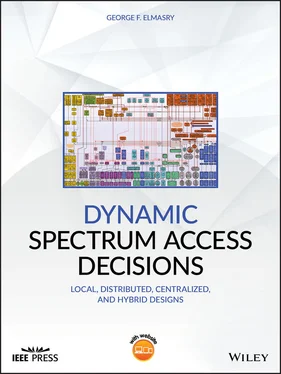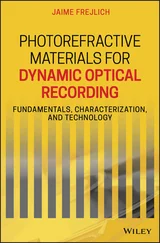1 Cover
2 Dedication I would like to thank the IEEE for allowing the DySPAN‐SC material to be included in this book. I also would like to thank Dr. James Stevens, the networking fellow at Collins Aerospace, and Dr. Thomas Tapp, the product owner of DSA capabilities at Collins Aerospace for their valuable input to this book. The DySPAN‐SC material made this book a comprehensive reference for engineers developing DSA systems and Dr. Stevens's and Dr. Tapp's reviews and suggestions added so much value to this text.
3 About the Author About the Author Dr. George F. Elmasry was born in Egypt and received a Bachelor of Science in Electrical Engineering and Electro‐physics from Alexandria University, Egypt in 1985. He then went on to receive a Master of Science and a PhD in Electrical Engineering from the New Jersey Institute of Technology (NJIT) in 1993 and 1999, respectively. Dr. Elmasry has over 25 years of industrial experience in commercial and defense telecommunications and is currently part of the Advanced Technology Center of Collins Aerospace, which is a forward‐looking research and development organization for defense and commercial aerospace telecommunications systems. Dr. Elmasry has an interdisciplinary background in electrical and computer engineering and computer science. He is active in research, patenting, publications, grant proposals as well as system engineering of defense and commercial aerospace wireless communications systems. He has experience with technical task leads, team building and management. Dr. Elmasry has over 50 peer‐reviewed publications and countless patents that pertain to network resource management, network management, network operation, software defined radios, cognitive networking, resilient communications and network and transport layers algorithms. Dr. Elmasry has authored a book on tactical wireless communications and networking that has been used as a textbook for graduate and senior level courses in different universities in the United States and internationally. He also authored part of the McGraw‐Hill encyclopedia on the history of military radios. In addition to his publications and patents activities, Dr. Elmasry has been a technical member of the annual Military Communications Conference (MILCOM) since 2003, where he has participated in session organization, paper reviews and session chairing. Dr. Elmasry is also a senior member of the Institute of Electrical and Computer Engineering (IEEE), a member of the Armed Forces Communications and Electronics Association (AFCEA) International, a Member of Sigma Xi and a member of Alpha Epsilon Lambda, the NJIT graduate‐student honor society. Dr. Elmasry holds countless awards, including the prestigious Hashimoto Award for achievement and academic excellence in electrical and computer engineering.
4 Preface
5 List of Acronyms
6 About the Companion Website
7 Part I DSA Basic Design Concept Chapter 1: Introduction 1.1 Summary of DSA Decision‐making Processes 1.2 The Hierarchy of DSA Decision Making 1.3 The Impact of DSA Control Traffic 1.4 The Involvedness of DSA Decision Making 1.5 The Pitfalls of DSA Decision Making 1.6 Concluding Remarks Exercises Bibliography Chapter 2: Spectrum Sensing Techniques 2.1 Multidimensional Spectrum Sensing and Sharing 2.2 Time, Frequency, and Power Spectrum Sensing 2.3 Energy Detection Sensing 2.4 Signal Characteristics Spectrum Sensing 2.5 Euclidean Space Based Detection 2.6 Other Sensing Techniques 2.7 Concluding Remarks Exercises Appendix 2A: The Difference Between Signal Power and Signal Energy Bibliography Chapter 3: Receiver Operating Characteristics and Decision Fusion 3.1 Basic ROC Model Adaptation for DSA 3.2 Adapting the ROC Model for Same‐channel in‐band Sensing 3.3 Decision Fusion 3.4 Concluding Remarks Appendix 3A: Basic Principles of the ROC Model The ROC Curve as Connecting Points 3A.2 The ROC Curve Classifications Bibliography Chapter 4: Designing a Hybrid DSA System 4.1 Reasons for Using Hybrid DSA Design Approaches 4.2 Decision Fusion Cases 4.3 The Role of Other Cognitive Processes 4.4 How Far can Distributed Cooperative DSA Design go? 4.5 Using a Centralized DSA Arbitrator 4.6 Concluding Remarks Exercises Bibliography
8 Part II Case Studies Chapter 5: DSA as a Set of Cloud Services 5.1 DSA Services in the Hierarchy of Heterogeneous Networks 5.2 The Generic DSA Cognitive Engine Skeleton 5.3 DSA Cloud Services Metrics 5.4 Concluding Remarks Bibliography Chapter 6: Dynamic Spectrum Management for Cellular 5G Systems 6.1 Basic Concepts of 5G 6.2 Spatial Modeling and the Impact of 5G Dense Cell Deployment 6.3 Stages of 5G SI Cancellation 6.4 5G and Cooperative Spectrum Sensing 6.5 Power Control, Orthogonality, and 5G Spectrum Utilization 6.6 The Role of the Cell and End‐User Devices in 5G DSM 6.7 Concluding Remarks Bibliography Chapter 7: DSA and 5G Adaptation to Military Communications 7.1 Multilayer Security Enhancements of 5G 7.2 MIMO Design Considerations 7.3 Multifaceted Optimization of MU MIMO Channels in Military Applications 7.4 Other Security Approaches 7.5 Concluding Remarks Bibliography Chapter 8: DSA and Co‐site Interference Mitigation 8.1 Power Spectral Density Lobes 8.2 Co‐site Interference between Frequencies in Different Bands 8.3 Co‐site Interference From Unlicensed Frequency Blocks 8.4 Adapting the Platform's Co‐site Interference Analysis Process for DSA Services 8.5 Adapting the External System's Co‐site Interference Analysis for DSA 8.6 Considering the Intersystem Co‐site Interference Impact 8.7 Using Lookup Tables as Weighted Metrics 8.8 Co‐site Interference Incorporation in Decision Fusion and Fine‐Tuning of Co‐site Impact 8.9 DSA System co‐site Interference Impact on External Systems 8.10 The Locations Where Co‐site Interference Lookup Tables and Metrics are Utilized 8.11 Concluding Remarks Bibliography
9 Part III United States Army's Techniques for Spectrum Management Operations Chapter 9: Overview 9.1 Electromagnetic Spectrum 9.2 Definition 9.3 Objective 9.4 Core Functions 9.5 Army Spectrum Management Operations Process Chapter 10: Tactical Staff Organization and Planning 10.1 Spectrum Management Operations for Corps and Below 10.2 Division, Brigade and Battalion Spectrum Operations 10.3 Spectrum Managers Assigned to Cyber Electromagnetic Activity Working Group 10.4 Cyber Electromagnetic Activities Element 10.5 Tips for Spectrum Managers 10.6 The Military Decisionmaking Process 10.7 Support to the MDMP Steps 10.8 The Common Operational Picture Chapter 11: Support to the Warfighting Functions 11.1 Movement and Maneuver 11.2 Intelligence 11.3 Fires 11.4 Sustainment 11.5 Mission Command 11.6 Protection Chapter 12: Joint Task Force Considerations 12.1 Inputs and Products of Joint Task Force Spectrum Managers 12.2 Joint Frequency Management Office 12.3 Joint Spectrum Management Element 12.4 Spectrum Management Support to Defense Support of Civil Authorities Chapter 13: Spectrum Management Operations Tools 13.1 Tool Considerations 13.2 Joint Spectrum Interference Resolution Online 13.3 Joint Spectrum Data Repository Appendix A: Spectrum Management Task List A.1 Tasks A.2 Sub‐task List A.3 SMO to EW Flow Charts Appendix B: Capabilities and Compatibility between Tools B.1 Capabilities and Compatibility Appendix C: Spectrum Physics C.1 Radio Frequency Appendix D: Spectrum Management Lifecycle D.1 Spectrum Management Lifecycle Appendix E: Military Time Zone Designators E.1 Overview ReferencesRequired Publications Related Publications Army Publications Prescribed Forms Referenced Forms Websites
10 Part IV The IEEE Standards 1900x – 2019 – Dynamic Spectrum Access Networks Standards Committee (DySPAN-SC) Chapter 14: IEEE Standard for Definitions and Concepts for Dynamic Spectrum Access: Terminology Relating to Emerging Wireless Networks, System Functionality, and Spectrum Management14.
Читать дальше












